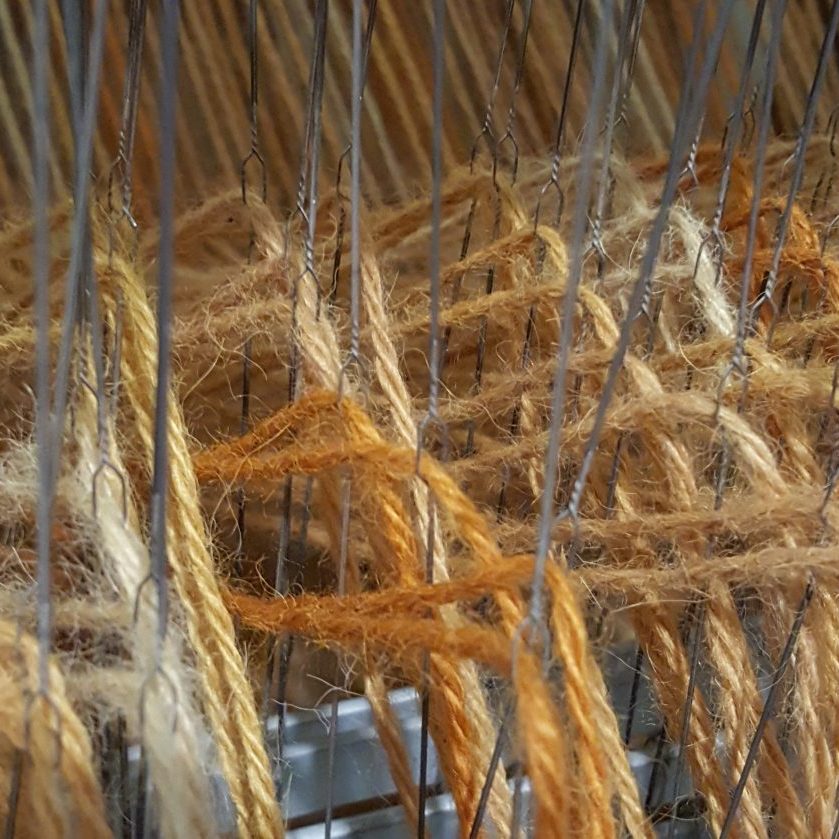Category Archives: Uncategorized
The Green Man
L’homme vert, der grüner Mann, el hombre verde, an fear glas
I came across this natural moss portrait along the Sturt River / Warriparri in Coro this week – the Green Man enjoying watching the world go by from the trunk of an ash tree on the bank of the creek. The child in me is always seeing faces and characters, human and otherwise, in tree trunks and rocks, and this was a wonderful encounter, especially at this time of year.
The ash (and willows, etc.) are non-native and considered weed species here, but I still love seeing them everywhere. The smell of the greenery and the water (when the creek hasn’t dried out for the summer) brings back memories of summer in England. There’s often a heron to be seen, as well as families of ducks and all sorts of plants. The local council has just extended the linear path even further and has provided picnic tables along the way. It’s a great place for walking doggy.
There’s some more info on the Green Man as well as an interesting poem about him on this website.
Friend or foe?
Ami ou ennemi? Freund oder Feind? ¿Amigo o enemigo? Cara nó namhaid?
The kaka beak (Clianths puniceus) flowered even more impressively this year, to the point where I wasn’t so much wow-ing the display, rather thinking that this was what had been expected all along. Impressive nonetheless. As usual, after the flowers came the signs of chewed leaves, only this time the culprits were to be seen…
I haven’t been able to identify them yet, but I think they’re moth larvae, maybe the peppered moth. With some species I turn to biological control, if they happen to be a non-native species, but with these something told me that they might actually be useful.
I’ve planted a couple of seedlings of New Guinea bean – Lagenaria siceraria – and have previously noticed the flowers open at night. Pollinated by moths? The larvae have since disappeared, and as they were so well camouflaged, I’m hoping that it was because they moved on to their next stage of development.
Clianthus puniceus
Kaka beak, Kōwhai Ngutu-kākā, Papageienschnabel
It must’ve been over fifteen years ago that I bought a packet each of red and white kaka beak seeds from New Zealand (legally and through the post). This was after only one successful attempt at growing our native Sturt’s desert pea. I had it in my head that kaka beak needed to be sown in autumn, and so two or three years in a row I sowed a pot of each colour, saw a few grow, some even to their first pair of true leaves, then cark it.
A few years ago I came across the remaining seeds, and repeated the experiment, this time checking with a supplier on the optimum sowing time. Seems they can be planted for most of the year. The first re-attempt came to nought, but out of the second attempt I ended up with four plants of the red. None of the white ones came up, but I might try again, considering the viability of the red seeds. How could I tell them apart? The red-flowering ones are black, and the white-flowering ones a pale brown.
 My largest specimen (not full-sized by any means) grew buds last year, but these dried up on a particularly hot day. The specimen was later planted behind a retaining wall at the side of the house, and I’ve watched the buds develop eagerly. Then today, the first open flower!
My largest specimen (not full-sized by any means) grew buds last year, but these dried up on a particularly hot day. The specimen was later planted behind a retaining wall at the side of the house, and I’ve watched the buds develop eagerly. Then today, the first open flower!
I guess there are some people, particularly “across the ditch”, laughing at this great achievement. Well, I still get a kick any time seeds germinate. Always have done. Always will. And now one’s flowering.
Back to the plant per se, it seems that it is critically endangered in the wild and restricted to one location. Thankfully it’s not so rare in cultivation.
Noch a bisle mehr entdeckt…
(English version below)
Habe ich das Buch vor einer Woche auf Google Books gefunden. Es wurde in Fraktur gedruckt. Der Autor hieß Joseph Mollenhauer: praktisch gelerneter Färber zu Fuld. Und das Titel: Praktischer und sehr anwendbarer Waid und Schoenfaerber zum Gebrauch für Wertmesiter und Liebhaber.
Die Vorrede beginnt so: Da ich wegen politischer Verfassung des Staates meine praktische Kentniße nicht weiter benutzen kann noch darf; so bin von vielen Freunden aufgefordert worden, diese meine Färbkenntniße gemeinnützig zu machen.
Ich habe noch nichts um die politische Verfassung zu dieser Zeit in Hesse herasugefunden. Trotzdem wird das Buch mir immer mehr interessant. Kann es das Original sein, oder eine Kopie?
Vor der Vorrede wird geschrieben – und es scheint in zwei Shriftarten zusammen – Dieses färbbuch gefördert (?) mir Johann Henrich Marx… November 1806. Die Vorrede wurde aber am 30 April 1801 geschrieben. Vielleicht wurde denn diese Inschrift vom Verwandten geschrieben? So viele Fragen, die ohne Zeitmaschine nicht werden beantwortet können..
A little more uncovered…
I was able to find a printed copy of the work on Google Books, written in Fraktur – a lot easier to understand! It was written in 1801 by Joseph Mollenhauer: experienced dyer at Fuld, and titled Practical woad and beautiful colours for the use of professionals and enthusiasts. I’m still deciding on the best translation, so don’t quote me on that for the time being.
So, was this the original, or a handwritten copy? Just before the introduction there is a page that states This book was …. to me by Johann Henrich Marx… November 1806. This inscription seems to be written in two different scripts, and with the word for “this” – dieses – looking more like vinfub, you can understand the difficulty in trying to decipher it. What is clear is that the introduction was written on 30th April, 1801.
The author begins his introduction, Because I can’t practise my craft any longer due to the State constitution, many friends have asked me to pass on my dyeing knowledge. I haven’t yet been able to find out what the constitutional thingamajig was, but have been wondering why my BA couldn’t have included being thrown such a work and being told to go and research it…
Wenn man/frau Kurrent lesen kann…
(English version below…)
Einer Mitgliederin unseres Bundes wurde dieses Buch von ihrem Großvater gegeben. Das Buch wurde 1801-1806 im Schwarzwald geschrieben, wo ihre Verwandte beim Marxfabrik in Lambrecht arbeitete. Es liegt jetzt im Lutheranischen Arkiv hier in Adelaide. Ein Faksimile bleibt mit dem Handspinners and Weavers Guild SA. Das Foto wird mit Genehmigung kopiert.
 Am Anfang des Buches steht das Alphabet in normaler Handschrift. Auf der nächsten Seite steht das Aphabet in Kurrentschrift. Ein sehr deutiger Schlüssel, aber trotzdem ist die Schrift sehr schwer zu lesen.
Am Anfang des Buches steht das Alphabet in normaler Handschrift. Auf der nächsten Seite steht das Aphabet in Kurrentschrift. Ein sehr deutiger Schlüssel, aber trotzdem ist die Schrift sehr schwer zu lesen.
Das nächste Projekt besteht darauf, das Buch in moderne Schrift (sowie auch auf Englisch) übersetzen und drucken zu lassen.
Es war echt eine Vergnügen, solch einen historischen Schatz anzuschauen.
Dyeing, social history and languages all in one! It was such a pleasure to view this book, written in 1801-1806 in the Black Forest, where the author worked at the Marx wool factory. The handwriting alone is something to marvel at, even though it is difficult to read. Whilst studying in Germany, I was given a photocopy (from and English text!) of 1940’s Gothic alphabet to help me read official documents of that period. I have to say that Gothic script is a lot easier to understand than Kurrent! At the front of the book there is a page with the alphabet in regular handwriting, and on the opposite side the alphabet in Kurrent. Still difficult to read!
The book was given to a member of the HSWG SA by her grandfather, who inherited it from his relatives. The original has been kindly donated to the Lutheran Archive in Adelaide, whist a facsimile has been donated to the Guild.
It would be wonderful to find a way of transcribing and translating the book, and perhaps even getting it printed.
Pickled walnuts
Des noix marinées, eingelegte Walnüsse, nueces en escabeche, gallchnónna picilte
I first heard of these in an episode of Dear Ladies where they were dumped by one of the ladies on the dining table in front of the other with comic contempt. They seemed to be in one of those jars that you find every now and then over the years at the back of the cupboard, but never open or use. In Greece once we were served ice-cream (it was colourless, practically tasteless and had slathers of ice in it – maybe a packet mix?) with a sauce that tasted like something out of one of those jars. Most unusual for a country where fresh food is the norm and nothing is short of tasty. Anyway, the walnuts… I imagined walnuts as we usually eat them, shelled and halved, in a jar of vinegar.
I didn’t make the usual half-gallon of nocello this summer, but decided to pickle the green fruits instead using this recipe. I’d liken the process to pickling olives, but darker and stainier. 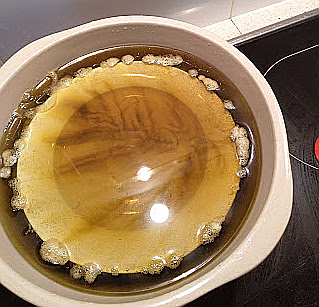 First came trimming (I’d had them in the fridge whilst deciding what to do; some of the ends were a bit brown), then pricking all over with a needle. The second picture, right, shows them after bathing in brine for a day. A friend asked if the plate was made of walnut, too. Good point, and I swear th
First came trimming (I’d had them in the fridge whilst deciding what to do; some of the ends were a bit brown), then pricking all over with a needle. The second picture, right, shows them after bathing in brine for a day. A friend asked if the plate was made of walnut, too. Good point, and I swear th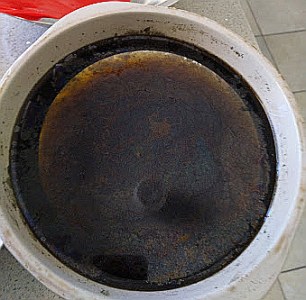 e pattern was purely by chance. It was however ordinary, white china.
e pattern was purely by chance. It was however ordinary, white china.
Then came the first change of brine. By this time, I’d given up on the idea of the bowl reverting to its original white colour at the end of the process. C’est la vie… The fruits themselves hadn’t changed so much, and it was back in for another bath after changing the brine. I’ll admit to leaving them in the second bath for a little longer than recommended, but it seems to have worked.
Finally they were fished out and strained, then left in the sun for a couple of days. With temperatures in the high 30’s and low 40′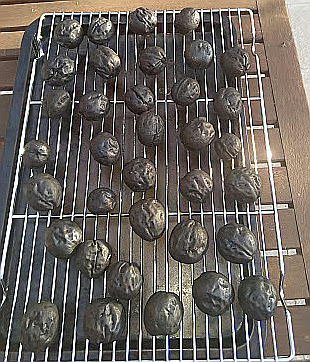 s I wondered if they might dry beyond redemption. Instead they turned a fantastic metallic shade, like Christmas beetles. And wrinkled. I still made sure they were handled with tongs (dyeing walnuts and spinning silk and wool means you need to pay special attention to all that potential dye, and your fingers).
s I wondered if they might dry beyond redemption. Instead they turned a fantastic metallic shade, like Christmas beetles. And wrinkled. I still made sure they were handled with tongs (dyeing walnuts and spinning silk and wool means you need to pay special attention to all that potential dye, and your fingers).
And th e result? They were simmered in the pickling mixture, then everything placed in a couple of jars with a glass milk watcher on top as a weight, and left for a couple
e result? They were simmered in the pickling mixture, then everything placed in a couple of jars with a glass milk watcher on top as a weight, and left for a couple 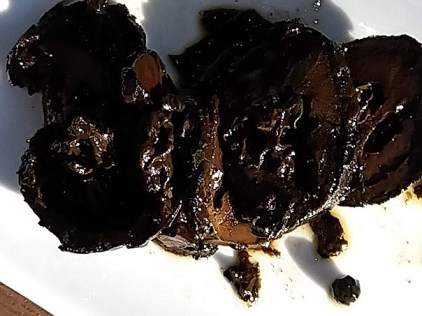 of months. Naturally one had to purchase some Stilton to go with them. The first one out was a little soft; it broke up but was still worth the effort – a sort of pickled pate. The second kept its shape more when cut. And the taste? Definitely worth the Stilton, and worth eating all of them by the time the next lot are ready. If they last that long. The picture really doesn’t do them justice.
of months. Naturally one had to purchase some Stilton to go with them. The first one out was a little soft; it broke up but was still worth the effort – a sort of pickled pate. The second kept its shape more when cut. And the taste? Definitely worth the Stilton, and worth eating all of them by the time the next lot are ready. If they last that long. The picture really doesn’t do them justice.
Syrian Oregano
Origanum syriacum, origan de Syrie, syrischer Oregano, orégano sirio, oragán siriach
 I grew some seeds of this a few years ago, about the same time that I was looking for za’atar. Some seed catalogues list them as one in the same, but with some research I found that za’atar can be Thymbra spicata, Origanum syriacum, Thymus vulgaris, Micromeria spp. or Hyssopus officinalis – depending on where you live and what grows locally.
I grew some seeds of this a few years ago, about the same time that I was looking for za’atar. Some seed catalogues list them as one in the same, but with some research I found that za’atar can be Thymbra spicata, Origanum syriacum, Thymus vulgaris, Micromeria spp. or Hyssopus officinalis – depending on where you live and what grows locally.
Back to the oregano… one plant survived from the seedlings and grew strongly, and has given me several offshoots since, and last season a harvest of seeds and subsequent seedlings. What I noticed this afternoon was that the plant was not only growing  strongly, but also has a couple of stems – on the one plant – with larger than usual leaves, so big that I had to run my finger down the stems to their origin to check they weren’t mint.
strongly, but also has a couple of stems – on the one plant – with larger than usual leaves, so big that I had to run my finger down the stems to their origin to check they weren’t mint.
Huge. I don’t know whether this is how the plant now wants to grow, or if it’s due to the weather that is constantly up-and-down at the moment, but will certainly try and take a cutting to see if the leaves stay that large.
And the taste? Spicy. Like some fellow herb growers, I’ve found that the alternative Greek oregano Origanum vulgare var. hirtum, just doesn’t grow well (perhaps dodgy original stock?). The Syrian variety is also more upright and the silvery foliage provides contrast.
Pomegranate
Punica granatum, écorce de grenade, Granatapfelschale, cáscara de granada, craiceann pomegranáit
I’ve had quite a stock of dried pomegranate peel sitting around in the larder (I refuse to call it a “pantry” as most Australian-born do – sounds too much like something out of Upstairs Downstairs and we don’t have a maid). So, after obtaining a beige tone on alpaca yarn some time ago, I wasn’t expecting anything more.
I used 200% wof on wool, and chose the bits of rind with the reddest colouring. The alkaline 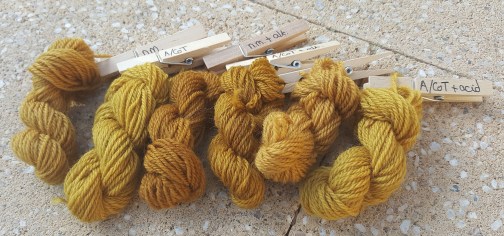 modifier (skeins 3 & 4) darkended the colours, whilst the acid modifier (5 & 6) lightened them. Skeins 1, 3 & 5 demonstrate that no mordant is required. Each shade obtained is, however, worthy in its own right and in real life all are far more vivid.
modifier (skeins 3 & 4) darkended the colours, whilst the acid modifier (5 & 6) lightened them. Skeins 1, 3 & 5 demonstrate that no mordant is required. Each shade obtained is, however, worthy in its own right and in real life all are far more vivid.
I had read somewhere that pomegranate, being high in tannin, is also worth consideration in making turmeric more light-fast… Wonder what it will do for alkanet? I just had to try, so in the dye bath mentioned in the previous post, six doppelgangers (that doesn’t seem right without the umlaut, aber ich bin sicher, Ihr konnt es mir vergeben) were thrown in for an overdye.

The original shades of pomegranate alone were strong and I suppose I should’ve repeated the experiment with yellow rind, and maybe at 100% wof. Oh well, let’s just shove some skeins in the pot and see what we get…
…more interesting shades with pinky (and perky) overtones. The light-fast testing will be interesting. Tomorrow’s been downgraded to 41oC (how cool…) whilst Sunday is still forecast to be 42oC. Even if it stays below that, there’s plenty of UV around for the tes t.
t.
Just as an aside, I “marked” the pre-dyed pomegranate skeins with some bits of other wool. How did they emerge from the alkanet bath? GREY AND PURPLE! Grr!!!
Trip to Clare
The main reason for going to Clare Valley is dog-friendly holiday accommodation. The wineries, historic townships and change of scenery all add to the experience. Then there’s a shop that sells, amongst other things, spinning and weaving equipment…
 I’d “chatted” to Tracy a few times by email about workshops, so it was a pleasure to finally meet in person. Her shop, Knit Spin Weave is a yarnaholic’s treasure trove, complete with working looms, spinning wheels and numerous smaller items that you see on websites, but rarely up close and touchable. Added to that is personal, friendly service from someone who clearly loves to share the enthusiasm.
I’d “chatted” to Tracy a few times by email about workshops, so it was a pleasure to finally meet in person. Her shop, Knit Spin Weave is a yarnaholic’s treasure trove, complete with working looms, spinning wheels and numerous smaller items that you see on websites, but rarely up close and touchable. Added to that is personal, friendly service from someone who clearly loves to share the enthusiasm.
I could have easily spent more time there, but did return after a brief lunch to buy a SampleIt loom so that I could start playing around with more textured yarns and colour combinations. I had to forgo the offer of a free set-up and play lesson as partner and doggie had already been patient enough. Still, now I don’t have to drool over pictures of shops interstate and abroad where you can walk in, see & touch before you buy, then walk out with your purchase in hand.
